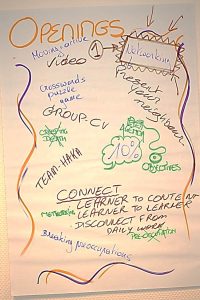Carousel Walk
Here’s a great interactive review technique (actually my favourite review technique) that involves all your learners, lets you step back and can be utilised at different points during your workshop such as:
- After lunch.
- To start day 2+ of a workshop.
- To close a workshop.
- To start part 2 of a workshop where there has been a couple of weeks break.
 The technique – which I call the ‘Carousel Walk’ – like the fun fair ride.
The technique – which I call the ‘Carousel Walk’ – like the fun fair ride.
Preparation
Prepare the following during the lunch break, before learners arrive for day 2 etc
- Select 3 or 4 key topic areas from the workshop so far (you need to have teams of 3-4 learners working on each topic area eg if I had 12 learners I’d select 3 topic areas and divide the workshop into 3 teams of 4 learners).
- Write each topic area on the top of a separate flip chart sheet (I always draw a colourful border around the flip chart sheet just to finish it off).
Post the flip chart sheets onto the wall. I personally like to do this outside of the training room ie in the corridoor area. Place the flip chart sheets far enough apart to allow teams to work together without encroaching on other teams. If you cannot use outside the training room, put each flip chart sheet on a different wall within the training room.
 Facilitating the Activity
Facilitating the Activity
- Divide the group into teams ie the same number of teams as you have flip chart sheets. I tend to go around the room numbering people eg if I want 3 teams I’d count learners off 1, 2. 3, 1, 2, 3 etc. This means I have learners working with learners from other teams who may not have worked together yet.
- Ask the 1’s to follow you. Lead them to the first prepared flip chart sheet.
- Hand them a pen and ask them to wait there. Let them know they have nothing further to do just yet.
- Do the same for each team you’ve created.
- Ask teams to work together and bullet point everything they know about the topic written at the top of their flip chart sheet. The person holding the pen will do the writing.
- Allow 2-3 minutes.
- Ask teams to pause.
- Ask the person with the pen to hand it to someone else in their team.
- Ask teams to rotate to the next flip chart sheet in a clockwise direction.
- Ask teams to read what’s currently on their new flip chart and then to add new ideas and expand some of the points already written,
- Repeat the process until each team has visited each flip chart sheet – always suggesting that the person with the pen hands it to someone who hasn’t done any writing so far.
- Ask teams to rotate one more time – taking them back to their original flip chart sheet.
- Ask teams to take 1-minute, evaluate the points on the flip chart and circle what they feel to be the key point.
You may want to allow time for learners to bring the completed flip chart sheets into the training room (or to the front of the room) and allow 4-6 minutes to capture any of the key points in their workbook.
To convert this into a close, when learners have visited each tip, ask them to revisit each flip chart and select the one idea from each that they will do first and add these to their action plan.
 What happened?
What happened?
- Your learners reviewed content – plus you can see if any key areas were missed that you will need to weave back into content during the rest of the workshop.
All your learners were involved in the review. - The review was active getting your learners moving and interacting.
- Nobody was put-on-the-spot.
- It was fun.
Bonus
Why not adapt this as an opening activity. Add key content areas to the top of the flip chart sheets and carry out the activity as described. Using this method, learners will be able to see where their current knowledge level is. You can see the experience and knowledge you have in the room and it ticks all the boxes of bringing learners mentally into the room, connecting learners together and linking learners to the content. You could always leave the flip chart sheets on the wall and re-visit them at the end of the workshop having learners add all the new things they now know.
Call to action |
|---|
| Review is about our learners not us. Therefore, always make sure that any review is learner centred and not facilitator lead. Try this technique in your next workshop. I’d love to hear how you utilise my favourite review technique. |

